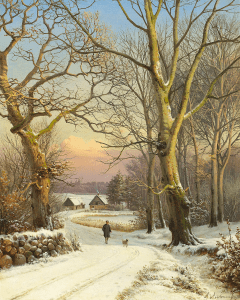We support our Publishers and Content Creators. You can view this story on their website by CLICKING HERE.
 I have always been a keen walker, or “hiker” in the American idiom. I have ambled, rambled, scrambled or otherwise perambulated across large swathes of England, Scotland, Wales and Ireland; I have roamed around Europe; and I have even ventured, since my arrival on this side of the Pond fourteen years ago, to traipse through parts of the New World. I am happy to walk alone or with friends, and I am always happy to walk with ghosts.
I have always been a keen walker, or “hiker” in the American idiom. I have ambled, rambled, scrambled or otherwise perambulated across large swathes of England, Scotland, Wales and Ireland; I have roamed around Europe; and I have even ventured, since my arrival on this side of the Pond fourteen years ago, to traipse through parts of the New World. I am happy to walk alone or with friends, and I am always happy to walk with ghosts.
I once walked across the length of Sussex in the company of the ghost of Hilaire Belloc, the most convivial of companions, reading his book The Four Men, which charted his own walk along the same route a century earlier. Belloc had embarked upon his pilgrimage through his beloved “south country” with four “ghosts” of his imagination, Grizzlebeard, the Sailor, the Poet, and Myself, each of whom was a figure and figment of Belloc’s own multifaceted persona. I was, therefore, in retracing his footsteps, in the company of five delightful ghosts! There was Belloc himself and his four imaginative alter egos.
I have also followed Belloc’s “path to Rome,” taking the path he took from Toules in France, across the Alps into Italy. On this occasion, however, I did it from the comfort of an armchair, following the pilgrim’s progress by turning the pages of his masterful book. I was with him in spirit, or rather my spirit was joined to his, but my body tarried in its sedentary state, enjoying the journey vicariously.
There’s much to be said for this other type of walking, the sort of literary peregrination upon which we embark when we follow Frodo through Middle-earth, Odysseus on his Odyssey, Dante on his pilgrimage into the netherworld, or Professor Otto Lidenbrock on his journey to the centre of the earth. These are all marvelous adventures which we can still enjoy even when our own wearied and withering limbs are no longer a match for the more arduous type of walking.
One of my favourite walks of this sort is to follow C.S. Lewis in The Pilgrim’s Regress, in which the pseudo-autobiographical protagonist traverses the Mappa Mundi of Lewis’s philosophical imagination, arguing with heretics and battling with dragons. I was, therefore, delighted to learn that a new annotated edition of this under-read and underrated classic has just been published (The Pilgrim’s Regress: Wade Annotated Edition, 2014), edited and introduced by David C. Downing, a Lewis scholar of deservedly solid repute, whose work I have known for years. Few works of Lewis are in more need of annotation than this allegorical journey through intellectual error and I was excited to see how Downing’s notes would illustrate Lewis’s path to conversion.
For the most part, Downing does not disappoint, guiding us with meticulous and scholarly care through the more difficult parts of the journey. Take, for instance, his elegant and eloquent debunking of those who have sought to see elements of racism in Lewis’ depiction of lust as being made manifest by the presence of “brown girls”. Asking us, first of all, to compare the brown girl at the beginning of the story with the character Wanton in Bunyan’s Pilgrim’s Progress, Lewis’s archetype in fashioning his own “Regress,” Downing then quotes from Lewis’s own writings to illustrate that his “brown girls” are more likely to be modeled on the erotically charged female figures in William Morris’s romantic reverie, The Well at the World’s End:
In that story, the hero has a number of amorous encounters with barmaids, milkmaids, and women bathing naked out of doors. Morris describes women’s attractiveness several times in terms of their tanned skin or bronzed legs, so Lewis seemed to associate “brown girls” with the nubile outdoorsy maidens who appear regularly in Morris’s episodic tale.
This is literary annotation at its best, exposing the pride and prejudice of the agenda-driven literati and at the same time enlightening and enriching our own enjoyment of the text.
Similarly the character Mr. Halfways is described in the notes as “a composite figure personifying decadent Romanticism”, especially as seen in the godless fantasizing of Morris and the morally and rationally unhinged aestheticism of Keats. In annotating the allegorical meaning of Gus Halfways, Mr. Halfways son, Downing prudently quotes Lewis’s own exposition of this character as signifying “[t]he ‘realism’ and cynisicm of the ‘dirty twenties’ (1920-1930) in reaction against Romanticism and therefore here represented as its son”. In Lewis’s odyssey through recent intellectual history, he is therefore seeing the realism of the twentieth century Modernists as being nothing but the reaction of an alienated son against the romanticism of its nineteenth century father: Eliot and Joyce as signifying a knee-jerk reaction against the romantic reveries of William Morris, John Keats, and also, by extension, Blake, Coleridge, Wordsworth, Shelley, Tennyson, et cetera. Such a sweeping generalization, for all its getting to the kernel of a real truth, lacks nuance and sensibility, a fact that Lewis would concede when, in the Afterword to the third edition of The Pilgrim’s Regress, he described himself as being “heartily ashamed” of what he termed the “preposterous allegorical filigree” in which he sought to dismiss all the errors of modernity as being nothing but a rejection of Romanticism.
Shortly after meeting Gus Halfways, the spirit of anti-romantic Modernism, John, the pseudo-Lewis protagonist, meets some of Gus’s fellow travelers, the so-called Clevers, in Zeitgeisthem, a place where Modernism melds fashion with fascism. Here he meets a curious bearded man who “wore nothing but a red shirt and a cod-piece made of the skins of crocodiles.” This bearded poet holds all the Clevers spellbound as he “began to beat on an African tom-tom” and “croon with his voice, swaying his lean, half-clad body to and fro,” “staring at them all, out of eyes which were like burning coals.” Who is this mysterious bearded man, the epitome of dark and brutal machismo in the midst of his androgynous modernist neighbours? As I suspected, Downing does not name him. Perhaps he does not even know him. In my next article, I will reveal the identity of the real-life poet who inspired this ominous savage. Next week, all will be revealed as we continue to walk with C.S. Lewis, this time into the jungles of darkest Africa.
This essay was first published here in August 2015.
The Imaginative Conservative applies the principle of appreciation to the discussion of culture and politics—we approach dialogue with magnanimity rather than with mere civility. Will you help us remain a refreshing oasis in the increasingly contentious arena of modern discourse? Please consider donating now.
The featured image is “A winter day in the woods of Northern Zealand. A man walking his dog” (1874) by Anders Andersen-Lundby, and is in the public domain, courtesy of Wikimedia Commons.
Share This Story, Choose Your Platform!
Go to Top

 Conservative
Conservative  Search
Search Trending
Trending Current News
Current News 





